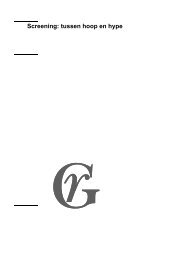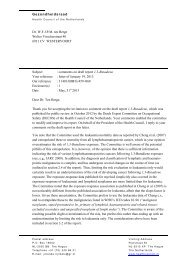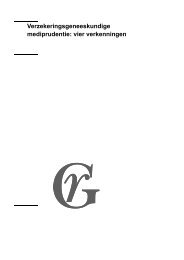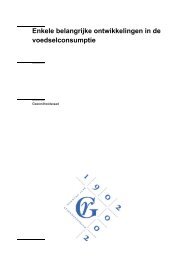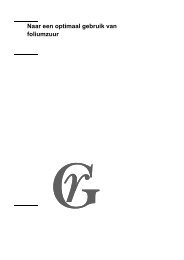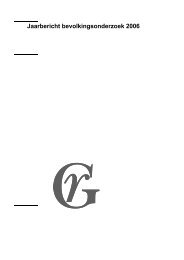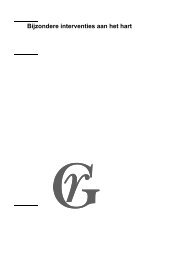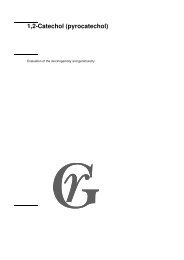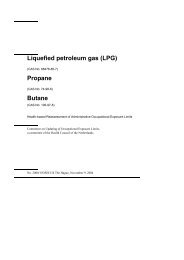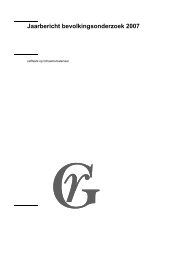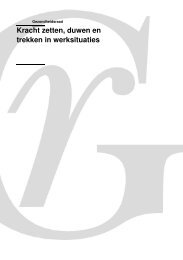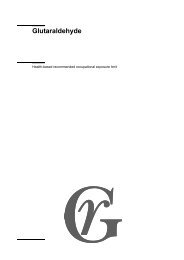Strychnine - Gezondheidsraad
Strychnine - Gezondheidsraad
Strychnine - Gezondheidsraad
Create successful ePaper yourself
Turn your PDF publications into a flip-book with our unique Google optimized e-Paper software.
eflexes but generally produced increased reflexes or tonic-clonic variable<br />
convulsions (ACG91).<br />
Based on maximally tolerated single doses, determined in a pilot experiment,<br />
of 8 and 2.5 mg/kg bw/day for males and females, respectively, male and female<br />
Sprague-Dawley/SIV rats (n=12/sex/group) were orally (gavage) exposed to<br />
strychnine (given as a 2% solution of strychnine hydrochloride in distilled water)<br />
at doses of 0, 5, and 10 or 0 and 2,5 mg/kg bw, respectively, for 28 days. Apart<br />
from haematological, blood chemistry, urinalysis, ophthalmological,<br />
macroscopic, and microscopic investigations, animals were submitted to a<br />
rotating rod test and an electrocardiography before and during treatment. Ten to<br />
20 minutes after each administration, the animals showed increased muscle tone<br />
and slight tremors gradually subsiding during the following hour. Mortality<br />
occurred in 1/12 and 5/12 male rats of the low- and high-dose group,<br />
respectively, and in 1/12 females. Animals died within 1/2 to 6 hours following<br />
administration showing tonic muscle contractions and respiratory paralysis and,<br />
at autopsy, pulmonary oedema and cyanosis. Comparison with control animals<br />
did not show treatment-related changes in body weight gains and food and water<br />
consumption or in any of the investigations performed (Sei82).<br />
The committee did not find further data on repeated-dose toxicity, including<br />
carcinogenicity or reproduction toxicity, of strychnine.<br />
Mutagenicity and genotoxicity<br />
<strong>Strychnine</strong> was stated to be negative in the gene mutation assay using S.<br />
typhimurium strains TA98, TA100, TA1537, and TA1538 (no reference or<br />
details presented (Wür91). It induced a dose-dependent increase in the frequency<br />
of Trp + genetic duplications in S. typhimurium strain TS1121 (aroC321 hisG46),<br />
with very high frequencies at high doses. Doses that were recombinagenic did<br />
not cause increases in the frequency of base-pair substitution or frameshift<br />
mutations in the hisG46, hisD3052, or hisC3076 alleles in the same strain<br />
(Hof87). <strong>Strychnine</strong> was stated to have induced mitotic recombination and/or<br />
gene conversion in S. cerevisiae (unpublished results; no details presented)<br />
(Wür86).<br />
<strong>Strychnine</strong> did not induce sex-linked recessive lethal mutations or<br />
clastogenic effects in D. melanogaster germ cells (unpublished results; no details<br />
presented) (Wür86). In somatic Drosophila cells, it was negative in the whiteivory<br />
reversion assay when tested at one single dose of 1.14 mM (Wür91) while<br />
111-12 Health-based Reassessment of Administrative Occupational Exposure Limits



